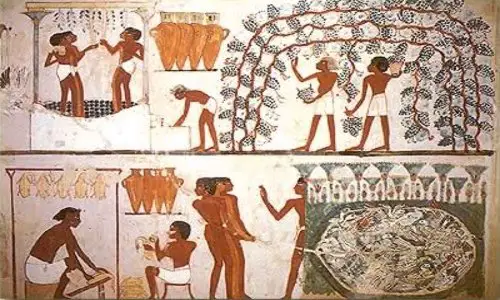
As soon as the flood began to recede the Ancient Egyptians ploughed the soil ready for sowing. They had hand ploughs or larger ones that were pulled by oxen. Seeds were then sewn into the newly ploughed soil. Goats and other animals then walked over the fields to push the seeds into the ground. Egyptian Crops grown included wheat, barley, flax, onions, leeks, garlic, beans, lettuce, lentils, cabbages, radishes, turnips, grapes, figs, plums, and melons.
Two Egyptian Crops Seasons
There were two seasons that affected farming: growing season and harvest season. In the harvest season, you may not have been able to harvest the wheat you wanted because your landlord may have made you cut his first.
Tools Used in Ancient Egypt
The tools used in ancient Egypt agriculture included: plows, sickles, hoes, forks, scoops, baskets, shaduf, skiffs, and sieves. The farmers also used cattle, oxen, donkey, and goats to aid in the cultivation of their fields. In the cultivation of grain, there were eight steps that the ancient farmer knew as well as he knew his own land. The cultivated land was ploughed with a wooden axe.

The fruit grown consisted of dates, figs, grapes, pomegranates, and melons. Due to the wonderful variety of flowers grown in ancient Egypt, bees were able to pollinate and produce honey. The pharaoh got the rich peasants to do the farm work on the rich lands. The peasants worked as either reapers or gleaners. The reapers went through the fields first and they did work such as plowing the field to loosen the dirt for the seeds to go in or they would winnow. Winnowing means to get the debris off of grain.
The ancient Egyptians were thorough in their cultivation of grain, as it was their main staple. Barley and emmer were used to make bread and beer. Excessive grain was exported to neighboring countries. This exportation of grain allowed the Egyptian treasury to accumulate income.
Some exporting of crops also took place; as far as agricultural products are concerned, mostly grains were exported. ox, cattle, and donkeys were used to pull equipment and pigs, sheep, and goats were sometimes used cover seeds so that the task needn’t be done by hand.